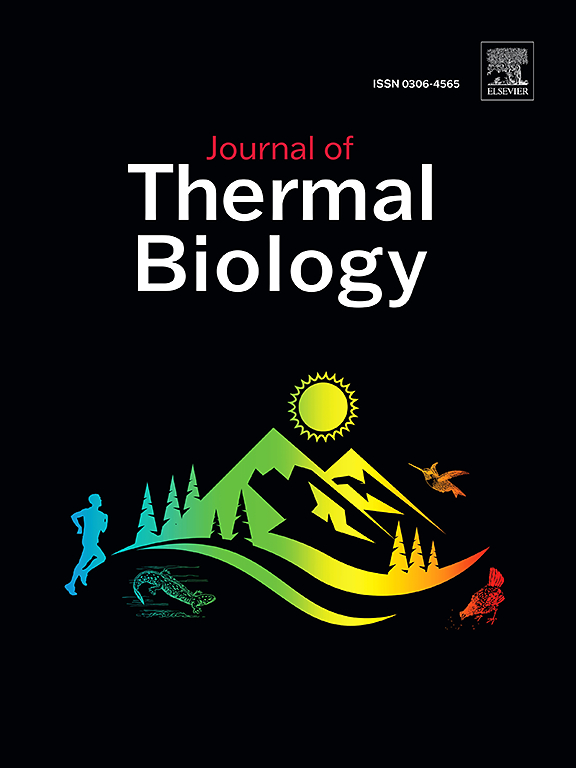基于红外热成像的层理系统覆盖度识别研究
IF 2.9
2区 生物学
Q2 BIOLOGY
引用次数: 0
摘要
研究了如何在无接触的情况下实时识别层理系统覆盖率(BSCR)这一具有挑战性的新问题。为了克服这一问题,提出了一种将红外热成像与图像分割算法相结合的方法。在3种拍摄角度(45°,60°,90°)和3种环境温度(23°C, 26°C, 29°C)下,采集30名受试者的常见覆盖形式的红外热像,评估这些因素对识别精度的影响。将该方法应用于夏季BSCR的实时识别。并收集主观热感觉(热感觉投票、热舒适投票)和客观睡眠质量。测试了三种图像分割方法。K-means聚类对BSCR的识别效果较好,MAE为3.70,RMSE为4.67,R2为0.901。红外摄像机的最佳拍摄角度为60°。此外,夏季室内温度(23°C - 29°C)对识别精度没有显著影响。在热舒适和良好睡眠质量条件下,睡眠时的平均BSCR为76.6%。值得注意的是,女性的BSCR比男性高8.9% (p <;0.01)。本研究为建立非接触睡眠热舒适预测模型提供了参考数据和见解。本文章由计算机程序翻译,如有差异,请以英文原文为准。
Research on recognition of bedding system coverage rate using infrared thermal imaging
This study investigated a new challenging problem: how to recognize bedding system coverage rate (BSCR) in real-time without contact. To overcome this problem, a method combining infrared thermal imaging with image segmentation algorithms was proposed. The infrared thermal images of 30 subjects with common coverage forms were captured under three shooting angles (45°, 60°, 90°) and three ambient temperatures (23 °C, 26 °C, 29 °C) to evaluate the effect of these factors on recognition accuracy. The proposed method was then applied in real-time to recognize BSCR in summer. And the subjective thermal perceptions (thermal sensation votes, thermal comfort votes) and objective sleep quality were collected. Three image segmentation methods were tested. And the K-means clustering excelled in recognizing BSCR, achieving an MAE of 3.70, RMSE of 4.67, and of 0.901. The optimal shooting angle for infrared camera was 60°. Additionally, the summer indoor temperature (23 °C–29 °C) had no significant impact on the recognition accuracy. The average BSCR during sleep was 76.6 % under conditions of thermal comfort and good sleep quality. Notably, females exhibited the BSCR that was 8.9 % higher than that of males (p < 0.01). This study provides reference data and insights for establishing a non-contact sleep thermal comfort prediction model.
求助全文
通过发布文献求助,成功后即可免费获取论文全文。
去求助
来源期刊

Journal of thermal biology
生物-动物学
CiteScore
5.30
自引率
7.40%
发文量
196
审稿时长
14.5 weeks
期刊介绍:
The Journal of Thermal Biology publishes articles that advance our knowledge on the ways and mechanisms through which temperature affects man and animals. This includes studies of their responses to these effects and on the ecological consequences. Directly relevant to this theme are:
• The mechanisms of thermal limitation, heat and cold injury, and the resistance of organisms to extremes of temperature
• The mechanisms involved in acclimation, acclimatization and evolutionary adaptation to temperature
• Mechanisms underlying the patterns of hibernation, torpor, dormancy, aestivation and diapause
• Effects of temperature on reproduction and development, growth, ageing and life-span
• Studies on modelling heat transfer between organisms and their environment
• The contributions of temperature to effects of climate change on animal species and man
• Studies of conservation biology and physiology related to temperature
• Behavioural and physiological regulation of body temperature including its pathophysiology and fever
• Medical applications of hypo- and hyperthermia
Article types:
• Original articles
• Review articles
 求助内容:
求助内容: 应助结果提醒方式:
应助结果提醒方式:


